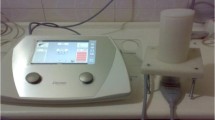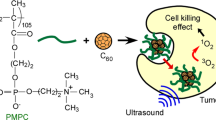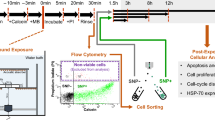Abstract
In this study, we investigated the induction of apoptosis by ultrasound in the presence of the photochemically active gallium–porphyrin complex, 7,12-bis(1-decyloxyethyl)-Ga(III)-3,8,13,17-tetramethyl-porphyrin 2,18-dipropionyl diaspartic acid (ATX-70). HL-60 cells were exposed to ultrasound for up to 3 min in the presence and absence of ATX-70, and the induction of apoptosis was examined by analyzing cell morphology, DNA fragmentation, and caspase-3 activity. Cells treated with 80 μM ATX-70 and ultrasound clearly showed membrane blebbing and cell shrinkage, whereas significant morphologic changes were not observed in cells exposed to either ultrasound or ATX-70 alone. Also, DNA ladder formation and caspase-3 activation were observed in cells treated with both ultrasound and ATX-70 but not in cells treated with ultrasound or ATX-70 alone. In addition, the combination of ATX-70 and the same acoustical arrangement of ultrasound substantially enhanced nitroxide generation by the cells. Sonodynamically induced apoptosis, caspase-3 activation, and nitroxide generation were significantly suppressed by histidine. These results indicate that the combination of ultrasound and ATX-70 induces apoptosis in HL-60 cells. The significant reduction in sonodynamically induced apoptosis, nitroxide generation, and caspase-3 activation by histidine suggests that active species such as singlet oxygen are important in the sonodynamic induction of apoptosis.





Similar content being viewed by others
References
Kremkau FW (1979) Cancer therapy with ultrasound. J Clin Ultrasound 7:287–300
Lele PP (1982) Local hyperthermia by ultrasound. In: Nussbaum GH (ed) Physical Aspect of Hyperthermia. American Institute of Physics, New York, pp 393–440
Rosenthal I, Sostaric ZJ, Riesz P (2004) Sonodynamic therapy—a review of the synergistic effects of drugs and ultrasound. Ultrason Sonochem 11:349–363
Yu T, Wang Z, Mason TJ (2004) A review of research into the uses of low level ultrasound in cancer therapy. Ultrason Sonochem 11:95–103
Umemura S, Kawabata K, Sasaki K, Yumita N, Umemura K, Nishigaki R (1996) Recent advances in sonodynamic approach to cancer therapy. Ultrason Sonochem 3:S187–S191
Tachibana K, Uchida T, Hisano S, Morioka E (1997) Eliminating adult T-cell leukaemia cells with ultrasound. Lancet 349:9048
Abe H, Kuroki M, Tachibana K, Li T, Awasthi A, Ueno A, Matsumoto H, Imakiire T, Yamauchi Y, Yamada H, Ariyoshi A, Kuroki M (2002) Targeted sonodynamic therapy of cancer using a photosensitizer conjugated with antibody against carcinoembryonic antigen. Anticancer Res 22:1575–1580
Bellnier DA, Ho YK, Panday RK, Missert JR, Dougherty TJ (1989) Distribution and elimination of Photofrin II in mice. Photochem Photobiol 50:221–228
Dougherty TJ (1993) Photodynamic therapy. Photochem Photobiol 58:895–905
Umemura S, Yumita N, Nishigaki R (1993) Enhancement of ultrasonically induced cell damage by a gallium–porphyrin complex, ATX70. Jpn J Cancer Res 84:582–588
Umemura S, Yumita N, Nishigaki R, Umemura S (1990) Mechanism of cell damage by ultrasound in combination with hematoporphyrin. Jpn J Cancer Res 81:962–966
Umemura K, Yumita N, Nishigaki R, Umemura S (1996) Sonodynamically induced antitumor effect of pheophorbide a. Cancer Lett 102:151–157
Yumita N, Nishigaki R, Sakata I, Nakajima S, Umemura S (2000) Sonodynamically induced antitumor effect of 4-formyloximethylidene-3-hydroxy-2-vinyl-deuterio-porphynyl(IX)-6, 7-diaspartic acid (ATX-S10). Jpn J Cancer Res 91:255–260
Yumita N, Umemura S, Nishigaki R (2000) Ultrasonically induced cell damage enhanced by photofrin II: mechanism of sonodynamic activation. In Vivo 14:425–429
Yumita N, Nishigaki R, Umemura S (2000) Sonodynamically induced antitumor effect of photofrin II on colon 26 carcinoma. Cancer Res Clin Oncol 126:601–606
Yumita N, Sasaki K, Umemura S, Nishigaki R (1996) Sonodynamically induced antitumor effect of a gallium-porphyrin complex, ATX-70. Jpn J Cancer Res 87:310–316
Yumita N, Umemura S (2003) Sonodynamic therapy with photofrin II on AH130 solid tumor. Pharmacokinetics, tissue distribution and sonodynamic antitumoral efficacy of photofrin II. Cancer Chemother Pharmacol 51:174–178
Nakajima S, Hayashi H, Sakata I, Takemura K (1993) New photosensitizer ATX-S10 having Type I photoreaction. J Clin Exp Med (Igaku no Ayumi) 164:187–188 (in Japanese)
Yamamoto J, Hirano T, Li S, Koide M, Kohno E, Inenaga C, Tokuyama T, Yokota N, Yamamoto S, Terakawa S, Namba H (2005) Selective accumulation and strong photodynamic effects of a new photosensitizer, ATX-S10. Na(II), in experimental malignant glioma. Int J Oncol 27:1207–1213
Thompson CB (1995) Apoptosis in the pathogenesis and treatment of disease. Science 267:1456–1462
Wyllie AH (1980) Glucocorticoid-induced thymocyte apoptosis is associated with endogenous endonuclease activation. Nature 284:555–556
Vantieghem A, Assefa Z, Vandenabeel P (1998) Hypericin-induced photosensitization of HeLa cells leads to apoptosis or necrosis. Involvement of cytochrome c and procaspase-3 activation in the mechanism of apoptosis. FEBS Lett 440:19–24
Feril LB Jr, Kondo T, Takaya K, Riesz P (2004) Enhanced ultrasound-induced apoptosis and cell lysis by a hypotonic medium. Int J Radiat Biol 80:165–175
Feril LB Jr, Tsuda Y, Kondo T, Zhao QL, Ogawa R, Cui ZG, Tsukada K, Riesz P (2004) Ultrasound-induced killing of monocytic U937 cells enhanced by 2, 2’-azobis(2-amidinopropane) dihydrochloride. Cancer Sci 95:181–185
Feril LB Jr, Kondo T, Ogawa R, Zhao QL (2003) Dose-dependent inhibition of ultrasound-induced cell killing and free radical production by carbon dioxide. Ultrason Sonochem 10:81–84
Ashush H, Rozenszajn LA, Blass M, Barda-Saad M, Azimov D, Radnay J, Zipori D, Rosenschein U (2000) Apoptosis induction of human myeloid leukemic cells by ultrasound exposure. Cancer Res 60:1014–1020
Lagneaux L, de Meulenaer EC, Delforge A, Dejeneffe M, Massy M, Moerman C, Hannecart B, Canivet Y, Lepeltier MF, Bron D (2002) Ultrasonic low-energy treatment: a novel approach to induce apoptosis in human leukemic cells. Exp Hematol 30:1293–1301
Ando H, Feril LB Jr, Kondo T, Tabuchi Y, Ogawa R, Zhao QL, Cui ZG, Umemura S, Yoshikawa H, Misaki T (2006) An echo-contrast agent, Levovist, lowers the ultrasound intensity required to induce apoptosis of human leukemia cells. Cancer Lett 242:37–45
Feril LB Jr, Kondo T, Zhao QL, Ogawa R, Tachibana K, Kudo N, Fujimoto S, Nakamura S (2003) Enhancement of ultrasound-induced apoptosis and cell lysis by echo-contrast agents. Ultrasound Med Biol 29:331–337
Kim T, Jung U, Cho DY, Chung AS (2001) Se-methylselenocysteine induces apoptosis mediated by reactive oxygen species in HL-60 cells. Carcinogenesis 22:559–565
Foote CS (1991) Definition of type I and type II photosensitized oxidation. Photochem Photobiol 54:659–666
Hiraoka H, Honda H, Feril LB Jr, Kudo N, Kondo T (2006) Comparison between sonodynamic effect and photodynamic effect with photosensitizers on free radical formation and cell killing. Ultrason Sonochem 13:535–542
Goldstein S, Czapski G (1984) Mannitol as OH scavenger in aqueous solutions and biological systems. Int J Radiat Biol 46:725–729
Misik V, Riesz P (2000) Free radical intermediates in sonodynamic therapy. Ann N Y Acad Sci 899:335–348
Author information
Authors and Affiliations
Corresponding author
Rights and permissions
About this article
Cite this article
Yumita, N., Okudaira, K., Momose, Y. et al. Sonodynamically induced apoptosis and active oxygen generation by gallium–porphyrin complex, ATX-70. Cancer Chemother Pharmacol 66, 1071–1078 (2010). https://doi.org/10.1007/s00280-010-1264-6
Received:
Accepted:
Published:
Issue Date:
DOI: https://doi.org/10.1007/s00280-010-1264-6




